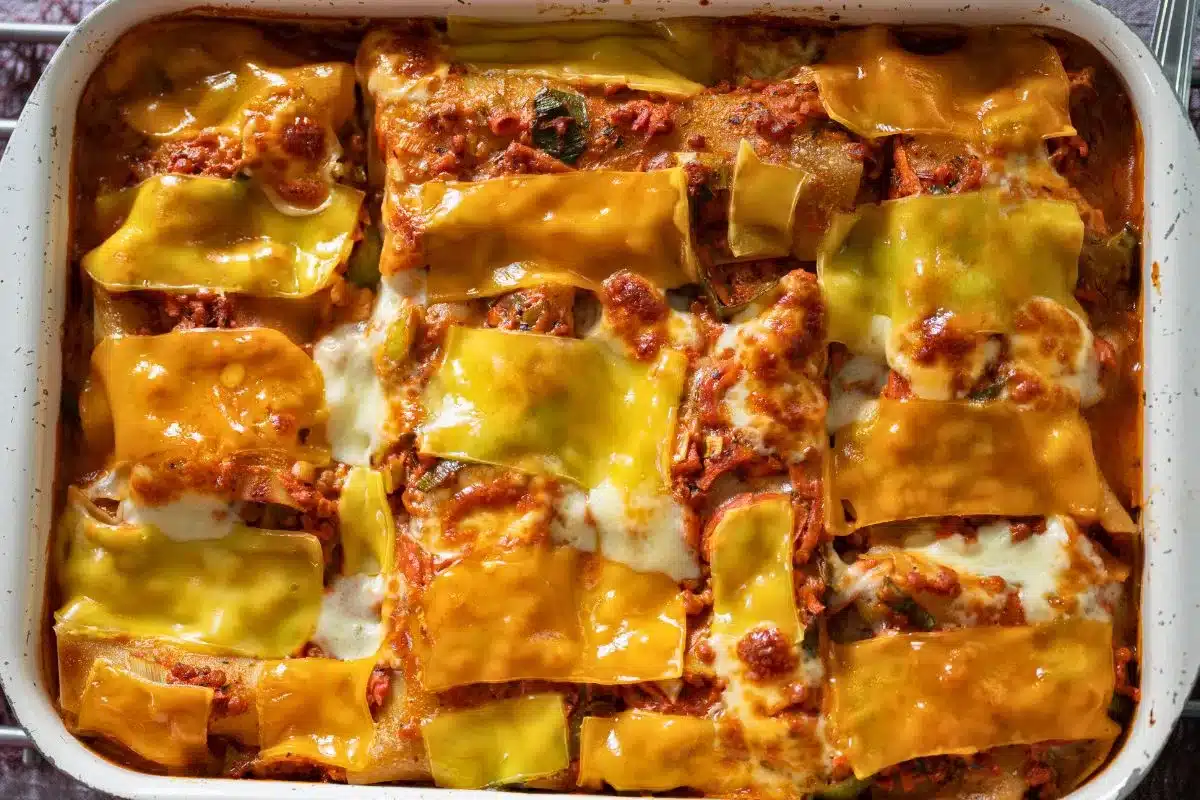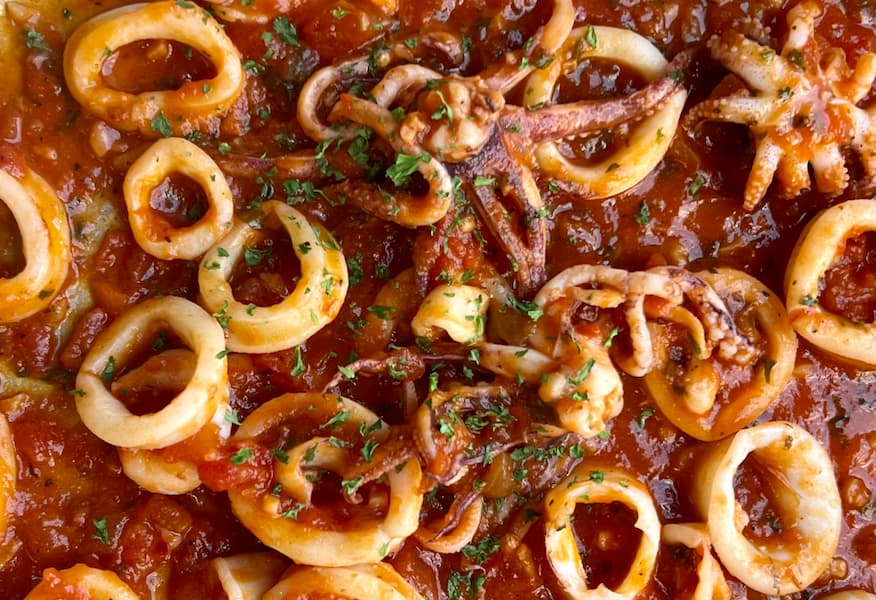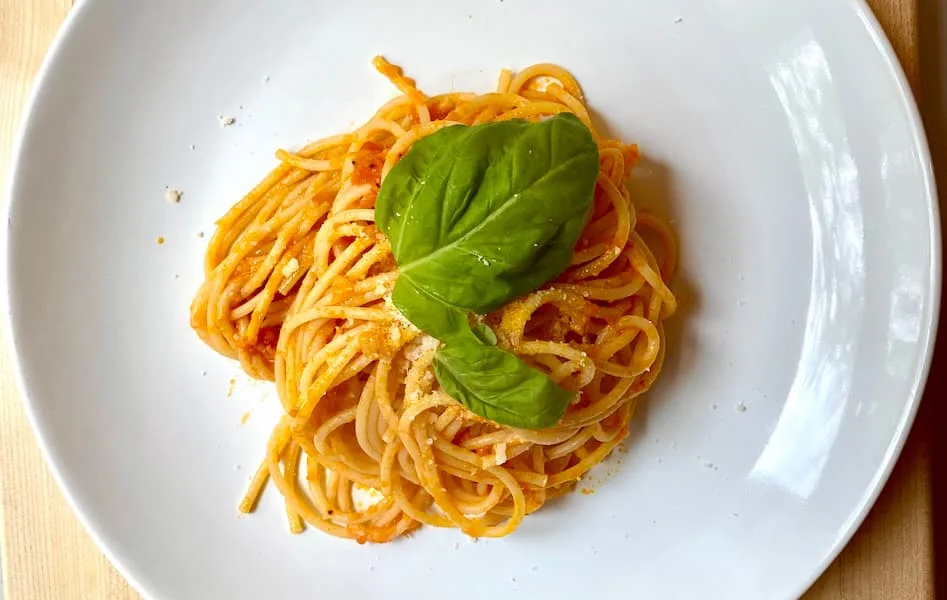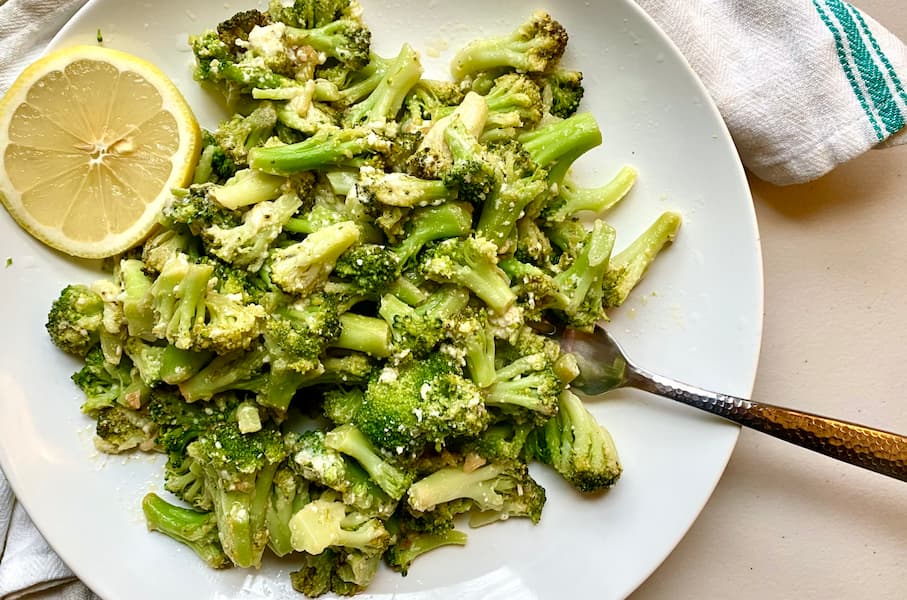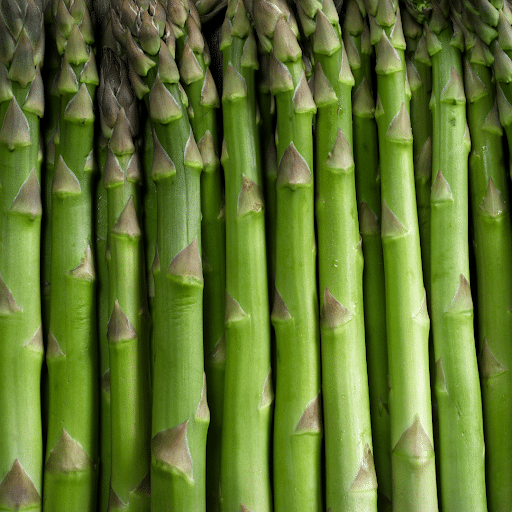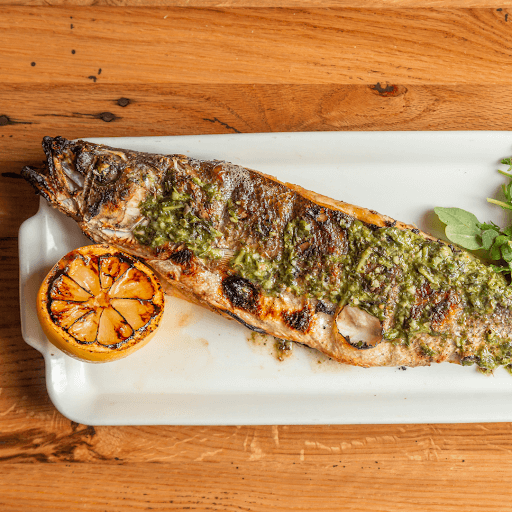In the world of culinary adventures, there are few Italian dishes as beloved and comforting as lasagna. Layers upon layers of tender pasta, creamy ricotta, rich meat sauce, and gooey mozzarella – if reading this won’t make you hungry, then I’m not sure what will.
Love lasagna, but stop anytime someone mentions it due to dairy? No worries! This dairy-free lasagna is just as creamy, delicious, and flavorful as the traditional lasagna recipe from Italy! So, preheat your oven, sharpen your appetite, and get ready to savor the magic of lasagna – all dairy-free and as authentic as possible.
*Psst* It’s also an amazing make-ahead meal!
What You Need for Dairy-Free Lasagna
Ready to put this together? Here’s what you need:
Ingredients for the Pasta:
- 12 lasagna noodles (preferably egg-free, gluten-free, or no boil noodles)
- Salt for boiling water
- Olive oil for drizzling
Tip: If you want to make your own pasta noodles, you need 100 g of all-purpose flour and 1 egg!
Ingredients for the Tomato Sauce (Ragu):
- 1 pound (450g) lean ground beef (or plant-based ground beef substitute for a vegan version)
- 1 onion, finely chopped
- 3 cloves garlic, minced
- 1 can (28 ounces) crushed tomatoes
- 1 can (14 ounces) diced tomatoes
- 2 tablespoons tomato paste
- 2 teaspoons dried basil
- 2 teaspoons dried oregano
- 1 teaspoon dried thyme
- Salt and pepper to taste
- Olive oil for cooking
Ingredients For the Bechamel Sauce
- 1/4 cup dairy-free butter (e.g., vegan margarine)
- 1/4 cup all-purpose flour (or gluten-free flour blend)
- 2 1/2 cups dairy-free milk (e.g., almond, soy, or oat)
- Pinch of nutmeg
- Salt and pepper to taste
Ingredients for the Filling (optional)
- 2 cups dairy-free vegan ricotta cheese (store-bought or homemade with tofu)
- 1 cup dairy-free shredded mozzarella cheese (your preferred brand)
- 1/2 cup nutritional yeast (for a cheesy flavor)
- Salt and pepper to taste
- Fresh spinach leaves (optional for added layers)
Note: You can fill your lasagna with any of this, though authentic lasagna is only layered with ragu and bechamel sauce!
Alternative Ingredients
Don’t you know this moment when you really want to make something, but you just don’t have everything on hand? Because same. Here’s a list of alternative simple ingredients you can use (and honestly, if you just use the basic ingredients for this, you’ll still get delicious food):
For the Ragu:
- Ground Meat Alternatives – Traditional ragu is made from ground pork and ground beef, however, you can also use ground lamb or turkey – you may just have a slightly different taste.
- Vegetarian Ragu – Use diced vegetables like zucchini, bell peppers, carrots, and eggplant. Sauté those with garlic and onions for added flavor, it will taste fantastic!
- Spices and Seasonings – Rosemary, thyme, fennel seeds, Italian seasoning, or paprika
- Diced Tomatoes Variations – Fire-roasted tomatoes or Italian-style diced tomatoes for a different flavor.
For the Bechamel Sauce:
- Alternative Flour – Gluten-free flour blend
- Dairy-Free Butter Alternatives – Coconut oil, olive oil, or vegan margarine.
- Non-Dairy Milk Choices – Almond, soy, oat, cashew, or coconut milk
- Seasonings – Garlic powder, onion powder, or a pinch of turmeric for color.
For the Filling:
- Dairy-Free Cheese Alternatives – Dairy-free shredded mozzarella cheese brands made from ingredients like coconut, soy, or almond. Alternatively, you can also make a homemade dairy-free cheese sauce using nutritional yeast, cashews, or potatoes.
- Tofu Ricotta – Blend firm tofu with nutritional yeast, lemon juice, garlic, salt, and pepper until creamy.
- Vegan Parmesan – Sprinkle vegan cheese or a mix of ground nuts and nutritional yeast on the top layer for added flavor.
- Spinach Alternatives – Kale or Swiss chard
- Extra Veggies – Roasted or sautéed veggies like roasted red peppers, artichoke hearts, or sliced olives.
How to Make Dairy-Free Lasagna
The thought of making lasagna may initially sound overwhelming, but the process is rather simple. The tomato sauce (ragu) will take the longest because it needs to simmer for many hours for the flavors to mend.
However, you could just prepare it ahead of time and make the assembly itself on time or a day in advance – yes, really!
Step 1: How to Prepare the Tomato Sauce (Ragu)
In a large skillet, heat a drizzle of olive oil over medium-high heat, then add the finely chopped onion and minced garlic – sauté until they become soft and translucent.
Add the ground beef (or plant-based substitute for a vegan version) and cook until it’s browned and cooked through, breaking it into crumbles as it cooks – the brown may look different than you’re used to if you use a combination of meats, but just make sure it’s no longer pink.
Once it’s not pink anymore, stir in the crushed tomatoes, diced tomatoes, tomato paste, dried basil, dried oregano, dried thyme, salt, and pepper and let the ragù simmer for about 1.5-2 hours, allowing it to thicken and really develop the flavors.
Tip: Use a slow cooker if you have one!
Step 2: How to Prepare the Dairy-Free Ricotta – Optional to Use!
In a bowl, combine the crumbled tofu, nutritional yeast, dairy-free milk, lemon juice, minced garlic, salt, and pepper and mix it well to create a ricotta-like consistency, then set aside.
Tip: Use a food processor if you have one!
Note: Authentic Lasagna only consists of Ragu and Bechamel sauce, however, if you’d still like to make a dairy-free ricotta sauce, here’s how!
Step 3: Cook the Lasagna Noodles
Meanwhile, cook the lasagna noodles in a large pot of water with some salt according to the package instructions until they are al dente. Then rinse them with cold water, drain, and set aside – alternatively, get the no boil lasagna noodles.
(Optional) How to Make Your Own Lasagna Noodles:
Put the flour in a medium bowl and make a well in the center with a spoon; this is where the egg will go. To incorporate the egg into the dough, use a fork to gently stir the area around the egg and the hole until it’s all gone – then let it rest for 30-60 minutes.
If the dough is still sticky after this step, add more flour and knead until it is no longer sticky – make sure not to add too much flour!
Next, prepare a clean work surface with a little bit of flour on it and roll out a portion of the dough in one direction alone before flipping it and repeating the process. Keep going until you have a large enough sheet to cut into 3–4 layers of noodles.
Step 4: How to Make Dairy-Free Bechamel Sauce
In a separate large saucepan, melt the dairy-free butter over medium heat, add the all-purpose flour, and whisk continuously to create a roux.
Then, gradually add the dairy-free milk while whisking to avoid lumps – personally, I think oats milk tastes great for this recipe. Continue to cook and whisk until the sauce thickens, about 5-7 minutes.
Lastly, add a pinch of nutmeg, salt, and pepper to taste and remove it from the heat.
Step 5: How to Layer and Assemble the Lasagna
First, preheat your oven to 375°F (190°C).
Then, grease a 9×13-inch baking dish with olive oil and begin layering the lasagna as follows: Start with a layer of lasagna noodles, followed by a layer of bechamel sauce and drizzles of the ragu sauce, before you add another layer of pasta – if you want to use dairy-free ricotta mixture or any other fillings add those before placing the pasta on top.
Repeat this layering process until you have at least 3-4 layers – finish the top of the lasagna with ragu and bechamel sauce.
Tip: To make it taste even better, let it cool off at room temperature and put it in the fridge for a few hours or overnight before cooking. You’ll be surprised how much better it will taste as it gives the layers time to set!
Step 6: Bake the Lasagna
Lastly, cover the top in aluminum foil and bake the lasagna in the preheated oven for 30 minutes. Then, remove the foil and bake for an additional 10-15 minutes or until the top is golden and bubbly – take it out and let it cool off for a few minutes before serving! Enjoy!Tip: Consider garnishing it with fresh basil or parsley on top
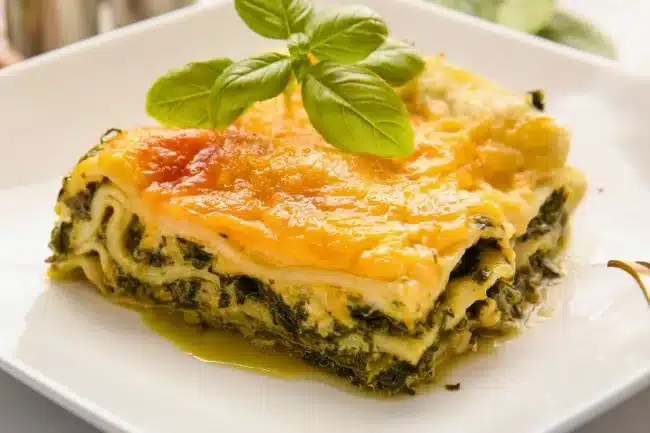
What to Serve Lasagna With
Keeping the rest light for a hearty meal like lasagna, full of rich flavors, is important. So, if you’re planning to serve a side, consider something like a crisp and refreshing salad with a mix of fresh greens and a tangy balsamic vinaigrette to balance the richness of the lasagna.
When it comes to drinks, a robust Italian red wine, like Chianti or Sangiovese, really pairs well with the savory flavors of the dish. If you prefer a non-alcoholic option, consider sparkling water with a hint of lemon or a fruity iced tea for a delightful sip – and let’s not forget dessert!
To prevent excess moisture, make sure to properly drain any cooked vegetables or ingredients and blot them dry if needed. Additionally, let the lasagna rest for a few minutes after baking to allow excess moisture to settle.
Frequently Asked Questions (FAQs)
Got questions about the vegan lasagna recipe? We have the answers!
How can I prevent my lasagna from becoming too watery?
To prevent excess moisture, make sure to properly drain any cooked vegetables or ingredients, and blot them dry if needed. Additionally, let the lasagna rest for a few minutes after baking to allow excess moisture to settle.
What’s the best type of cheese to use for dairy-free lasagna?
Various dairy-free cheese brands are available, made from ingredients like coconut, soy, almond, and cashews – I like to get dairy-free parmesan for this recipe!
How do I reheat lasagna without it becoming dry?
First off, don’t use a microwave unless you absolutely have to! Instead, cover it with aluminum foil and bake in a preheated oven at a lower temperature (around 325°F or 160°C) until it’s heated through – so, for about 5-10 mins max.
Print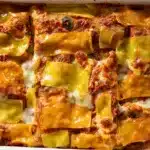
The Best and Easy Dairy-Free Lasagna Recipe
- Author: Anna Dykeman
Ingredients
Ingredients for the Pasta:
- 12 lasagna noodles (preferably egg-free, gluten-free, or no boil noodles)
- Salt for boiling water
- Olive oil for drizzling
Tip: If you want to make your own pasta noodles, you need 100 g of all-purpose flour and 1 egg!
Ingredients for the Tomato Sauce (Ragu):
- 1 pound (450g) lean ground beef (or plant-based ground beef substitute for a vegan version)
- 1 onion, finely chopped
- 3 cloves garlic, minced
- 1 can (28 ounces) crushed tomatoes
- 1 can (14 ounces) diced tomatoes
- 2 tablespoons tomato paste
- 2 teaspoons dried basil
- 2 teaspoons dried oregano
- 1 teaspoon dried thyme
- Salt and pepper to taste
- Olive oil for cooking
Ingredients For the Bechamel Sauce
- 1/4 cup dairy-free butter (e.g., vegan margarine)
- 1/4 cup all-purpose flour (or gluten-free flour blend)
- 2 1/2 cups dairy-free milk (e.g., almond, soy, or oat)
- Pinch of nutmeg
- Salt and pepper to taste
Ingredients for the Filling (optional)
- 2 cups dairy-free vegan ricotta cheese (store-bought or homemade with tofu)
- 1 cup dairy-free shredded mozzarella cheese (your preferred brand)
- 1/2 cup nutritional yeast (for a cheesy flavor)
- Salt and pepper to taste
- Fresh spinach leaves (optional for added layers)
Note: You can fill your lasagna with any of this, though authentic lasagna is only layered with ragu and bechamel sauce!
Alternative Ingredients
For the Ragu:
- Ground Meat Alternatives – Traditional ragu is made from ground pork and ground beef, however, you can also use ground lamb or turkey – you may just have a slightly different taste.
- Vegetarian Ragu – Use diced vegetables like zucchini, bell peppers, carrots, and eggplant. Sauté those with garlic and onions for added flavor, it will taste fantastic!
- Spices and Seasonings – Rosemary, thyme, fennel seeds, Italian seasoning, or paprika
- Diced Tomatoes Variations – Fire-roasted tomatoes or Italian-style diced tomatoes for a different flavor.
For the Bechamel Sauce:
- Alternative Flour – Gluten-free flour blend
- Dairy-Free Butter Alternatives – Coconut oil, olive oil, or vegan margarine.
- Non-Dairy Milk Choices – Almond, soy, oat, cashew, or coconut milk
- Seasonings – Garlic powder, onion powder, or a pinch of turmeric for color.
For the Filling:
- Dairy-Free Cheese Alternatives – Dairy-free shredded mozzarella cheese brands made from ingredients like coconut, soy, or almond. Alternatively, you can also make a homemade dairy-free cheese sauce using nutritional yeast, cashews, or potatoes.
- Tofu Ricotta – Blend firm tofu with nutritional yeast, lemon juice, garlic, salt, and pepper until creamy.
- Vegan Parmesan – Sprinkle vegan cheese or a mix of ground nuts and nutritional yeast on the top layer for added flavor.
- Spinach Alternatives – Kale or Swiss chard
- Extra Veggies – Roasted or sautéed veggies like roasted red peppers, artichoke hearts, or sliced olives.
Instructions
- How to Prepare the Tomato Sauce (Ragu) – use a slow cooker if you have one!
- In a large skillet, heat a drizzle of olive oil over medium-high heat, then add the finely chopped onion and minced garlic – sauté until they become soft and translucent.
- Add the ground beef (or plant-based substitute for a vegan version) and cook until it’s browned and cooked through, breaking it into crumbles as it cooks – the brown may look different than you’re used to if you use a combination of meats, but just make sure it’s no longer pink.
- Once it’s not pink anymore, stir in the crushed tomatoes, diced tomatoes, tomato paste, dried basil, dried oregano, dried thyme, salt, and pepper and let the ragù simmer for about 1.5-2 hours, allowing it to thicken and really develop the flavors.
- How to Prepare the Dairy-Free Ricotta – Optional to Use!
- In a bowl, combine the crumbled tofu, nutritional yeast, dairy-free milk, lemon juice, minced garlic, salt, and pepper and mix it well to create a ricotta-like consistency, then set aside.
- Cook the Lasagna Noodles in a large pot with water and some salt, then rinse them with cold water, drain, and set aside – or use no-boil lasagna noodles
- How to Make Dairy-Free Bechamel Sauce
- In a separate large saucepan, melt the dairy-free butter over medium heat, add the all-purpose flour, and whisk continuously to create a roux.
- Then, gradually add the dairy-free milk while whisking to avoid lumps
- Continue to cook and whisk until the sauce thickens, about 5-7 minutes.
- Add a pinch of nutmeg, salt, and pepper to taste and remove it from the heat.
- How to Layer and Assemble the Lasagna
- First, preheat your oven to 375°F (190°C).
- Grease a 9×13-inch baking dish with olive oil and begin layering the lasagna
- Start with a layer of lasagna noodles, followed by a layer of bechamel sauce and drizzles of the ragu sauce, before you add another layer of pasta – if you want to use dairy-free ricotta mixture or any other fillings add those before placing the pasta on top.
- Repeat this layering process until you have at least 3-4 layers – finish the top of the lasagna with ragu and bechamel sauce.
- Tip: To make it taste even better, let it cool off at room temperature and put it in the fridge for a few hours or overnight before cooking. You’ll be surprised how much better it will taste as it gives the layers time to set!
- Bake the Lasagna
- Cover the top with aluminum foil and bake lasagna in the oven for 30 minutes
- Remove the foil and bake for another 10-15 minutes or until the top is golden and bubbly
- Let it cool off and enjoy!
Instructions on how to make your own lasagna noodles:
- Put the flour in a medium bowl and make a well in the center with a spoon; this is where the egg will go.
- Incorporate the egg into the dough, use a fork to gently stir the area around the egg and the hole until it’s all gone – then let it rest for 30-60 minutes.
- If the dough is still sticky after this step, add more flour and knead until it is no longer sticky – make sure not to add too much flour!
- Prepare a clean work surface with a little bit of flour on it and roll out a portion of the dough in one direction alone.
- Flip it and repeat the process
- Keep going until you have a large enough sheet to cut into 3–4 layers of noodles.
Note: No need to cook these! The moisture from the lasagna will cook them.

